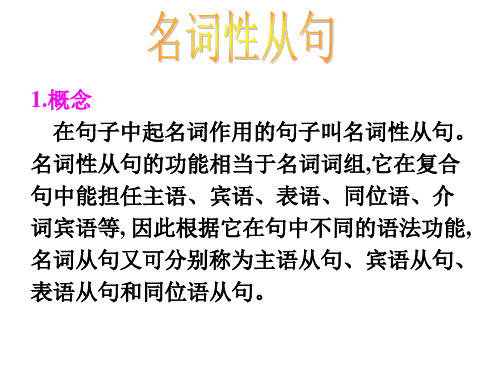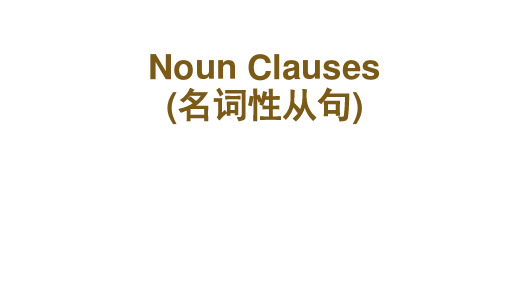初中英语名词性从句教学ppt课件
合集下载
名词性从句优秀课件ppt

同位语短语
Beijing ,the capital of China, is my hometown.
同位语从句
We heard the news that our team had won.
We were happy to hear the news that was announced by our boss.
定语从句
1. (2008山东)____ was most important to her was her family.
A. it
B. this
☆ C. What
D. as
主语从句
2. (2009北京,31)At first he hated the new job but decided to give
表语从句
表语从句位于连系动词后,有时用as if引导。 其基本结构为:主语 + 系动词 + that从句。 1. be, look, remain, 等系动词后均可跟表语从句: My suggestion is that we should go shopping. 2. as if 也可引导表语从句。
请你归纳
请你归纳
只能使用whether 的情况:
a. 主语从句并在句首 b. 表语从句 c. 同位语从句 e. 介词后的宾语从句
If 表-是否-
常用于动词
后的宾语从 句
f. 直接加动词不定式只能用whether (to do) g whether or not 直接连用时不用if
高考题选萃
1. ____ the 2000 Olympic Games will be
held in Beijing is not known yet.
Beijing ,the capital of China, is my hometown.
同位语从句
We heard the news that our team had won.
We were happy to hear the news that was announced by our boss.
定语从句
1. (2008山东)____ was most important to her was her family.
A. it
B. this
☆ C. What
D. as
主语从句
2. (2009北京,31)At first he hated the new job but decided to give
表语从句
表语从句位于连系动词后,有时用as if引导。 其基本结构为:主语 + 系动词 + that从句。 1. be, look, remain, 等系动词后均可跟表语从句: My suggestion is that we should go shopping. 2. as if 也可引导表语从句。
请你归纳
请你归纳
只能使用whether 的情况:
a. 主语从句并在句首 b. 表语从句 c. 同位语从句 e. 介词后的宾语从句
If 表-是否-
常用于动词
后的宾语从 句
f. 直接加动词不定式只能用whether (to do) g whether or not 直接连用时不用if
高考题选萃
1. ____ the 2000 Olympic Games will be
held in Beijing is not known yet.
名词性从句PPT课件

1.概念 在句子中起名词作用的句子叫名词性从句。
名词性从句的功能相当于名词词组,它在复合 句中能担任主语、宾语、表语、同位语、介 词宾语等, 因此根据它在句中不同的语法功能, 名词从句又可分别称为主语从句、宾语从句、 表语从句和同位语从句。
Who will win the match is still unknown.
whichever (book) you like.
whose
• Whose表示“谁的”。 • 在句子中充当定语的成分,其后一定会加
when, where, how, why, however… when, where, how, why, however…
that的用法
• 在从句中不充当任何成分,也没有任何具体意思。 • 引导的句子相当于一个陈述句。 • 只起到连接的作用。
主语 做及物动词宾语
宾语 做介词宾语
表语 同位语
一般不省略 可以省略 不可以省略 一般不省略 一般不省略
(3) It + 不及物动词+从句 It seems that… 似乎… It happened that… 碰巧… It appears that… 似乎…
(4) It is + 过去分词+从句 It is reported that… 据报道… It has been proved that… 已证实… It is said that… 据说…
He doesn’t know whether to stay or not. E) 后面紧接or not 时。如:
We didn’t know whether or not she was ready.
② 关联词只能用 whether或if, 不能用 that的情况如下:
名词性从句的功能相当于名词词组,它在复合 句中能担任主语、宾语、表语、同位语、介 词宾语等, 因此根据它在句中不同的语法功能, 名词从句又可分别称为主语从句、宾语从句、 表语从句和同位语从句。
Who will win the match is still unknown.
whichever (book) you like.
whose
• Whose表示“谁的”。 • 在句子中充当定语的成分,其后一定会加
when, where, how, why, however… when, where, how, why, however…
that的用法
• 在从句中不充当任何成分,也没有任何具体意思。 • 引导的句子相当于一个陈述句。 • 只起到连接的作用。
主语 做及物动词宾语
宾语 做介词宾语
表语 同位语
一般不省略 可以省略 不可以省略 一般不省略 一般不省略
(3) It + 不及物动词+从句 It seems that… 似乎… It happened that… 碰巧… It appears that… 似乎…
(4) It is + 过去分词+从句 It is reported that… 据报道… It has been proved that… 已证实… It is said that… 据说…
He doesn’t know whether to stay or not. E) 后面紧接or not 时。如:
We didn’t know whether or not she was ready.
② 关联词只能用 whether或if, 不能用 that的情况如下:
名词性从句ppt课件

.whether 与if 引导宾语从句有时可以换用,但哪些情况只能用whether?
介词后的宾从. Whether or not的宾从. 复合不定式只能用whether. 习惯上作discuss的宾从只用whether. 但: 宾语从句否定时常用if引导. 引导主语从句并置于句首时只用whether 引导表语从句只用whether 引导同位语从句时只用whether
名词性从句
点击此处添加正文,文字是您思想的提炼,请言简意赅的阐述您的观点。
By the end of the class , the Ss will grasp: The definition and types of the Noun Clauses Usages of the connectives(连接词) 1. that 与 what 2. if 与 whether 3. who 与 whoever 4.what 与 whatever
代词
主
表
宾
同位
what
whatever
whom
whose
which
whoever
whichever
whomever
when
why
where
how
that
whether
if
as if
as though
主语从句
宾语从句
表语从句
同位语从句
I. 名词性从句的种类
1.When we will start is not clear. 2.Mrs Black won’t believe that her son has become a thief. 3. My idea is that we should do it right now. 4.I had no idea that you were her friend.
名词性从句-完整版PPT课件精选全文

3. 连接副词:when(=the time when什么时候,何时),where(=the place where什么地方,何地),how(=the way that/in which怎样, 以……方式,如何),why=the reason why为什么)。它们除起连 接作用,还在从句中作状语。
3) wh类连接词引导的主语从句: wh类连接词包括wh类的连接代词(who, whom,
whose, which, what, whoever, whomever, whichever, whatever等)和连接副词(when,
where, how, why, whenever, wherever, however 等)。what, when和wh-ever类的词有时可不表 疑问。wh类连接代词在句中既起连接作用, 又可充当主语、宾语、表语、定语等成分。 wh类连接副词在句中起连接作用,在从句中 可充当时间、地点、原因、方式状语。
【温馨提示】 ①whether/ if引导宾语从句表示“是否”
的意思时,一般情况下可互换。 ②if引导宾语从句时可以有否定式,而
whether从句则没有。 e.g. I don’t care if he doesn’t come.
5) 特殊疑问词引导的宾语从句: 由who, what, how, which, whose, where, why等词引导的宾语从句,可作动词、 介词及形容词的宾语。
【温馨提示】 doubt, doubtful与sure后名词性从句连接词 that, whether, if的选择。 ①当doubt, doubtful用于肯定句时,后面的名
词性从句的连接词常用whether或if;当 doubt, doubtful用于否定句或疑问句时,后 面名词性从句的连接词用that。
初中英语名词性从句详解(共43张PPT)

4. 据说他已告诉了她一切.
It is said that he told her everything.
It is said只有 it 句型
More
注意: It looked that he was right. ( × ) 可以说: It looks as if….
用形式主语 it 的主语从句常见结构
stay.
b.介词后面的宾语从句不能用if. eg: I worry about whether I hurt
her feeling.
Practice time
if / whether
1. I asked her __if__/_w_h_e_t_he_rshe had a bike. 3. We’re worried about ________ he is safe. 4. I don’t know _________w__hehtheeirs well or not. 5. I don’t know ___w_h_e_th_e_ro/rifnot he is well. 8. I don’t know _______ to go.
4. This school is no longer what it was before. 这所学校已不再是从前的那个样子了. what =the thing that
More
注意下列表语从句中where, how, why 的译法
1. This is where Lu Xun once lived. 这就是鲁迅曾经住过的地方.
Note: It is important/necessary/natural/our duty/essential/strange
that sb (should) do sth. 固定句型, should可以省略
It is said that he told her everything.
It is said只有 it 句型
More
注意: It looked that he was right. ( × ) 可以说: It looks as if….
用形式主语 it 的主语从句常见结构
stay.
b.介词后面的宾语从句不能用if. eg: I worry about whether I hurt
her feeling.
Practice time
if / whether
1. I asked her __if__/_w_h_e_t_he_rshe had a bike. 3. We’re worried about ________ he is safe. 4. I don’t know _________w__hehtheeirs well or not. 5. I don’t know ___w_h_e_th_e_ro/rifnot he is well. 8. I don’t know _______ to go.
4. This school is no longer what it was before. 这所学校已不再是从前的那个样子了. what =the thing that
More
注意下列表语从句中where, how, why 的译法
1. This is where Lu Xun once lived. 这就是鲁迅曾经住过的地方.
Note: It is important/necessary/natural/our duty/essential/strange
that sb (should) do sth. 固定句型, should可以省略
名词性从句语法讲解课件

引导主语从句的常见引导词有that、 what、who、which等。
that在主语从句中不充当任何成分, 仅起连接作用;what、who、which 等引导词则需要在主语从句中充当相 应的成分。
主语从句的句型结构
主语从句的句型结构通常为“引导词+主语+谓语”,其中引导词是主语从句的开头, 主语是句子中的主要内容,谓语则用来表达主语的动作或状态。
例如:“What he said is not important.”(他所说的是不重要的。)这个句子中, “What he said”就是主语从句,“is”是谓语,“not important”是表语。
03 表语从句
表语从句的定义
表语从句是名词性从句的一种, 用作句子的表语成分,表示主 语的性质、状态或身份等。
表语从句的时态和主句时态保持一致,如果主句时态是现在时,则表语 从句时态也应该是现在时。如果主句时态是过去时,则表语从句时态也 应该是过去时。
04 宾语从句
宾语从句的定义
宾语从句是句子在复 合句中充当宾语成分 的句子。
宾语从句在句子中充 当宾语,对主句起到 补充说明的作用。
宾语从句可以由疑问 代词、疑问副词、陈 述代词或陈述副词引 导。
名词性从句的作用
01
02
03
表达意义
名词性从句能够完整地表 达一个概念或信息,使复 合句意义更加丰富。
补充说明
名词性从句可以用来补充 说明主句中的某个名词或 代词,提供更多细节。
强调重点
名词性从句可以用来强调 某个概念或信息的重要性, 突出主题。
名词性从句的引导词
陈述句引导词
01
that、what、which、who/whom等。
that在主语从句中不充当任何成分, 仅起连接作用;what、who、which 等引导词则需要在主语从句中充当相 应的成分。
主语从句的句型结构
主语从句的句型结构通常为“引导词+主语+谓语”,其中引导词是主语从句的开头, 主语是句子中的主要内容,谓语则用来表达主语的动作或状态。
例如:“What he said is not important.”(他所说的是不重要的。)这个句子中, “What he said”就是主语从句,“is”是谓语,“not important”是表语。
03 表语从句
表语从句的定义
表语从句是名词性从句的一种, 用作句子的表语成分,表示主 语的性质、状态或身份等。
表语从句的时态和主句时态保持一致,如果主句时态是现在时,则表语 从句时态也应该是现在时。如果主句时态是过去时,则表语从句时态也 应该是过去时。
04 宾语从句
宾语从句的定义
宾语从句是句子在复 合句中充当宾语成分 的句子。
宾语从句在句子中充 当宾语,对主句起到 补充说明的作用。
宾语从句可以由疑问 代词、疑问副词、陈 述代词或陈述副词引 导。
名词性从句的作用
01
02
03
表达意义
名词性从句能够完整地表 达一个概念或信息,使复 合句意义更加丰富。
补充说明
名词性从句可以用来补充 说明主句中的某个名词或 代词,提供更多细节。
强调重点
名词性从句可以用来强调 某个概念或信息的重要性, 突出主题。
名词性从句的引导词
陈述句引导词
01
that、what、which、who/whom等。
名词性从句讲解(共30张PPT)

This is his job. This is what he does every day.
I don’t like his job. I don’t like what he does every day.
I don’t know about the man, Mr. White. I don’t know about the fact that he is a teacher.
主语
表语
4. This is what he does every day.
主语
表语
5. I don’t like what he does every day. 动词宾语
主语
宾语
英语句子的种类
简单句 (simple sentence) 并列句 (compound sentence) 复合句 (complex sentence)
❖Lin Tao feels (that) his own team is even better. ❖She says (that) she won’t take part in the sports meeting next Sunday. ❖Jim thought (that) the train was like a big moving party.
引导词
连词 that, whether, if
疑问代词 who, whom, whose, which, what, whoever, whatever等
疑问副词 when, where, why, how等
Object Clause 宾语从句
1. I know him . (简单句)
主语 谓语 宾语
think, find, consider, believe, feel, make
I don’t like his job. I don’t like what he does every day.
I don’t know about the man, Mr. White. I don’t know about the fact that he is a teacher.
主语
表语
4. This is what he does every day.
主语
表语
5. I don’t like what he does every day. 动词宾语
主语
宾语
英语句子的种类
简单句 (simple sentence) 并列句 (compound sentence) 复合句 (complex sentence)
❖Lin Tao feels (that) his own team is even better. ❖She says (that) she won’t take part in the sports meeting next Sunday. ❖Jim thought (that) the train was like a big moving party.
引导词
连词 that, whether, if
疑问代词 who, whom, whose, which, what, whoever, whatever等
疑问副词 when, where, why, how等
Object Clause 宾语从句
1. I know him . (简单句)
主语 谓语 宾语
think, find, consider, believe, feel, make
英语名词性从句讲解PPT课件

I don’t know whether/if he will come.
I want to know whether he will come or not.
Are you talking about whether he will come?
He doesn’t care if it isn’t a fine day.
Our purpose is that he can realize his faults. 在句中充当表语的从句(即放在be动词后面)叫做表语从句。 我们的目的是他能认识到错误。 注意:引导表语从句的连接词一般不省略。
The question is whether it is worth doing 问题是它是否值得做 注意:表语从句表示“是否” 只用“whether” 而不用“if”
注意:在宾语从句中,表示“是否”既可以用whether,也可以用if.但是,whether常与or not连用;作介词宾语只用whether; 从句是否定句时一般用if。
宾语从句中的否定转移
我认为他不会来这里
I think he won’t come here. ( ) I don’t think he will come here. ( )
(主从)
(同位语从句)
(宾从)
(表从)
(同位ቤተ መጻሕፍቲ ባይዱ从句)
(定从)
(主从)
在句中充当主语的从句叫做主语从句。
注意:从句作主语时,就算是句子意思完整,都要加上从属连词that
注意:主语从句表示“是否” 只用“whether” 而不用“if”
他星期三来这里是肯定的。 That he will come here on Wednesday is certain.
I want to know whether he will come or not.
Are you talking about whether he will come?
He doesn’t care if it isn’t a fine day.
Our purpose is that he can realize his faults. 在句中充当表语的从句(即放在be动词后面)叫做表语从句。 我们的目的是他能认识到错误。 注意:引导表语从句的连接词一般不省略。
The question is whether it is worth doing 问题是它是否值得做 注意:表语从句表示“是否” 只用“whether” 而不用“if”
注意:在宾语从句中,表示“是否”既可以用whether,也可以用if.但是,whether常与or not连用;作介词宾语只用whether; 从句是否定句时一般用if。
宾语从句中的否定转移
我认为他不会来这里
I think he won’t come here. ( ) I don’t think he will come here. ( )
(主从)
(同位语从句)
(宾从)
(表从)
(同位ቤተ መጻሕፍቲ ባይዱ从句)
(定从)
(主从)
在句中充当主语的从句叫做主语从句。
注意:从句作主语时,就算是句子意思完整,都要加上从属连词that
注意:主语从句表示“是否” 只用“whether” 而不用“if”
他星期三来这里是肯定的。 That he will come here on Wednesday is certain.
名词性从句PPT课件

语态:被动语态和主动语态
被动语态
表示动作的接受者是主语,如 "The book was written by him."中的主语从句"The book was written"使用被动语态。
主动语态
表示动作的执行者是主语,如 "He wrote the book."中的主语 从句"He wrote the book"使用 主动语态。
抽象名词翻译
在汉译英时,有时需要将具体 名词抽象化,以使译文更加符
合英语表达习惯。
THANKS FOR WATCHING
感谢您的观看
04 名词性从句的特殊结构
it作形式主语
形式主语用于代替主 语从句,避免句子结 构不平衡。
It is important that we should learn English well.
It is+形容词/名词 +that+主语从句。
强调句型中的名词性从句
01
It
is/was+被强调部分
+that/who+句子其余部分。
表示现在的动作或状态,如"I know who he is."中的宾语 从句"who he is"使用现在时态。
过去时态
表示过去的动作或状态,如"He said that he was a student."中的宾语从句"he was a student"使用过去时态。
将来时态
表示将来的动作或状态,如"I will tell you what will happen."中的宾语从句"what will happen"使用将来时态。
名词性从句公开课课件

05
名词性从句在写作中的应用
在句子中添加细节信息
总结词
名词性从句能够提供更多的细述
在写作中,我们有时需要提供更多的细节信息来支持主句的 观点或描述。名词性从句,如定语从句和名词性主语从句, 可以用来补充相关的信息和细节,使句子更加完整和具体。
表达观点和立场
语态
主动语态
表示主语是动作的执行者。例如 :She wrote a letter.
被动语态
表示主语是动作的承受者。例如 :The letter was written by her.
04
名词性从句的特殊用法
as引导的名词性从句
总结词:指代内容
详细描述:as可以作为关系代词,引导定语从句,指代整个主句的内容,表示“ 像……一样”。
总结词
名词性从句可以用来连接句子和段落,使文 章更加连贯和流畅。
详细描述
在写作中,我们经常需要将不同的句子和段 落连接起来,以使文章更加连贯和流畅。名 词性从句,特别是状语从句和定语从句,可 以用来连接句子和段落,使文章更有条理。 通过使用名词性从句,我们可以更好地组织 文章的结构,使读者更容易理解我们的思路 和观点。
特点
示例
He studies hard, which is known to us all.
在从句中充当句子成分,表示“其中 的……”。
who/whom的用法
定义
who/whom用作连词时,引导名词性从句,是关系代词型的连接 词,用于指代人。
特点
who在从句中充当主语或宾语,whom只能充当宾语。
whether引导的名词性从句
总结词:选择内容
详细描述:whether可以引导名词性从句,表示选择内容,常用于表示“是否”的意思。
名词性从句讲解课件

that用作引导词,在名词性从句中不充当任何成 分,只起连接作用。
02 功能
用于引导主语从句、宾语从句、表语从句和同位 语从句。
03 例子
The news that he passed the exam was unexpected.(他通过考试的消息是出人意料 的。)
whether的用法
01
02
03
定义
whether用作引导词,在 名词性从句中充当成分, 表示“是否”。
功能
用于引导主语从句、宾语 从句、表语从句和同位语 从句。
例子
I don't know whether he will come or not. (我不知道他是否会来。)
who/whom/whose的用法
定义
who/whom/whose用作 引导词,在名词性从句中 充当成分,表示“谁”。
as引导的让步状语从句
总结词
表示转折关系
详细描述
as可以引导让步状语从句,表示“尽管、虽然”的意思。这种从句通常出现在主句之前,用于 强调从句中的内容。
than引导的比较状语从句
总结词
表示比较关系
详细描述
than可以引导比较状语从句,表示“比...更...”的意思。这种从句通常出现在主 句之后,用于强调两者之间的差异或优劣。
被动语态
表示主语是动作的接受者。例如:“It was said that the book would be published next year.”
时态与语态的结合使用
现在进行时的被动语态
表示正在被进行的动作或存在的状态。例如: “We are being told that the game is about to start.”
02 功能
用于引导主语从句、宾语从句、表语从句和同位 语从句。
03 例子
The news that he passed the exam was unexpected.(他通过考试的消息是出人意料 的。)
whether的用法
01
02
03
定义
whether用作引导词,在 名词性从句中充当成分, 表示“是否”。
功能
用于引导主语从句、宾语 从句、表语从句和同位语 从句。
例子
I don't know whether he will come or not. (我不知道他是否会来。)
who/whom/whose的用法
定义
who/whom/whose用作 引导词,在名词性从句中 充当成分,表示“谁”。
as引导的让步状语从句
总结词
表示转折关系
详细描述
as可以引导让步状语从句,表示“尽管、虽然”的意思。这种从句通常出现在主句之前,用于 强调从句中的内容。
than引导的比较状语从句
总结词
表示比较关系
详细描述
than可以引导比较状语从句,表示“比...更...”的意思。这种从句通常出现在主 句之后,用于强调两者之间的差异或优劣。
被动语态
表示主语是动作的接受者。例如:“It was said that the book would be published next year.”
时态与语态的结合使用
现在进行时的被动语态
表示正在被进行的动作或存在的状态。例如: “We are being told that the game is about to start.”
《名词性从句完整》课件

由连词引导的主语从句
连词+主语+谓语。例如:That he will come is certain.
由关系代词引导的主语从句
主语+谓语+关系代词+宾语。例如:What he said is true.
由关系副词引导的主语从句
主语+谓语+关系副词+宾语。例如:When he will come is unknown.
03
表语从句
表语从句的定义
表语从句
在复合句中,用作表语的从句, 放在系动词之后。
作用
补充说明主语或主句所表示的状 态、特征、身份等。
表语从句的引导词
01
02
03
04
that:无实际意义,仅 起连接作用。
whether:表示“是否 ”。
as if:表示“似乎、好 像”。
because:表示“原因 ”。
同位语从句的引导词
常用的同位语从句引导词是that,有 时也用what和how。
当同位语从句表示具体内容时,通常 用what引导;当同位语从句表示方式 或方法时,通常用how引导。
同位语从句的句型结构
同位语从句通常紧跟在引导词后面, 用逗号与前面的名词或代词隔开。
同位语从句的时态要与主句时态保持 一致,根据实际情况选择合适的时态 。
示例
What he said is not true. (宾语从 句)
名词性从句的分类
01
02
03
04
主语从句
在句子中充当主语的名词性从 句。
宾语从句
在句子中充当宾语的名词性从 句。
表语从句
在句子中充当表语的名词性从 句。
名词性从句优秀PPT课件

解析
A选项中“What”引导的是主语 从句,表示“他说的话不是真实 的”。B选项中“Who”引导的 是主语从句,表示“谁将去参加 会议还不知道”。C选项中 “Why”引导的是主语从句,表 示“他为什么离开学校还是一个 谜”。
THANKS
感谢观看
whom的用法
引导定语从句,相当于“whom”
引导名词性从句,相当于“who”
whose的用法
引导定语从句,表示“谁的”
引导名词性从句,表示“谁的”
which的用法
01
引导定语从句,相当于 “which”
02
引导名词性从句,相当于 “which”
03
名词性从句的时态与语序
时态的用法
一般现在时
A选项中“It is strange that…”是一个固定句型, 表示“奇怪的是…”,其中 that引导的从句是主语从句 。B选项中“It is a pity that…”也是一个固定句型 ,表示“遗憾的是…”,其 中that引导的从句是主语从 句。C选项中“where”引 导的是地点状语从句,表示 “在哪里”。
解决方案
在编写或修改名词性从句时,要特别注意主谓一致的问题,确保主语和谓语在 单复数形式上保持一致。
从句中的时态错误
时态不一致
在描述过去、现在或未来的事件时,时态的使用是关键。例 如,“If I was younger, I would do it”中,“was”与 “would do”之间存在时态不一致的错误。
用于表达过去某个时间正 在进行的动作。
时态的用法
过去完成时
用于表达过去的过去,即过去某个时 间之前发生的动作或状态。
过去完成进行时
用于表达过去的过去,即过去某个时 间之前正在进行的动作。
《名词性从句》课件

现在进行时
表示正在进行的动作或存在的状态。例如:They are knowing (that) he is studying.
现在完成时
表示过去的动作对现在的影响或结果。例如:He has known (that) she has left.
语态的用法
主动语态
表示主语执行的动作。例如:We found (that) he was studying.
不管什么样的”。
特点
what引导的名词性从句相当于一 个特殊疑问句。
使用场景
what常用于引导主语从句、宾语从 句和表语从句。
which的用法
定义
which用作连词时,引导名词性 从句,表示选择关系。
特点
which在从句中充当主语、宾语 或定语,表示选择范围。
使用场景
常用于引导宾语从句和定语从句 ,表示选择关系。
特点
具有名词的语法功能,同 时又保留了从句的句法结 构。
类型
主语从句、宾语从句、表 语从句和同位语从句。
名词性从句的种类
主ห้องสมุดไป่ตู้从句
在复合句中充当主语的 从句,通常放在句首。
宾语从句
在复合句中充当宾语的 从句,通常放在动词或
介词后。
表语从句
在复合句中充当表语的 从句,通常放在系动词
后。
同位语从句
在复合句中充当同位语 的从句,通常放在名词 后,对名词进行补充说
名词性从句的引导词
what、which、who/whom、whose等。
定语从句的引导词
that、which、who/whom、whose等。
从句在句子中的位置
名词性从句
可以位于句首、句中或句尾。
表示正在进行的动作或存在的状态。例如:They are knowing (that) he is studying.
现在完成时
表示过去的动作对现在的影响或结果。例如:He has known (that) she has left.
语态的用法
主动语态
表示主语执行的动作。例如:We found (that) he was studying.
不管什么样的”。
特点
what引导的名词性从句相当于一 个特殊疑问句。
使用场景
what常用于引导主语从句、宾语从 句和表语从句。
which的用法
定义
which用作连词时,引导名词性 从句,表示选择关系。
特点
which在从句中充当主语、宾语 或定语,表示选择范围。
使用场景
常用于引导宾语从句和定语从句 ,表示选择关系。
特点
具有名词的语法功能,同 时又保留了从句的句法结 构。
类型
主语从句、宾语从句、表 语从句和同位语从句。
名词性从句的种类
主ห้องสมุดไป่ตู้从句
在复合句中充当主语的 从句,通常放在句首。
宾语从句
在复合句中充当宾语的 从句,通常放在动词或
介词后。
表语从句
在复合句中充当表语的 从句,通常放在系动词
后。
同位语从句
在复合句中充当同位语 的从句,通常放在名词 后,对名词进行补充说
名词性从句的引导词
what、which、who/whom、whose等。
定语从句的引导词
that、which、who/whom、whose等。
从句在句子中的位置
名词性从句
可以位于句首、句中或句尾。
名词性从句讲解课件

特点
which在从句中担任成分 ,通常表示“哪个”、“ 哪些”。
例子
I don't know which book you like best. (我 用法
定义
例子
whose是一个限定词,用于引导名词 性从句,表示某个对象的所属关系。
I don't know whose book this is. ( 我不知道这是谁的书。)
分类
01
02
03
04
主语从句
在句子中充当主语的名词性从 句,通常放在句子的开头。
宾语从句
在句子中充当宾语的名词性从 句,通常放在动词或介词之后
。
表语从句
在句子中充当表语的名词性从 句,通常放在系动词之后。
同位语从句
在句子中充当同位语的名词性 从句,通常放在名词之后,对
名词进行补充说明。
02 名词性从句的引导词
总结词
在名词性从句中,从句与主句的逻辑关系经常处理不当。
详细描述
应仔细分析从句与主句之间的逻辑关系,确保从句的内容与 主句的内容相符合,避免出现逻辑上的矛盾或混乱。
感谢您的观看
THANKS
定义
why是一个副词,用于引导名词性从句,表示某 个原因或动机。
特点
why在从句中担任成分,通常表示“为什么”、 “因为什么”。
3
例子
I don't know why he left early. (我不知道他为 什么提前离开了。)
03 名词性从句的时态和语态
时态:现在时、过去时、将来时
现在时
表示现在或将来某个时间点发生的动作或存在的 状态。
强调句型
总结词
突出强调某个成分
名词性从句引导词ppt课件

连接副词(4个):when、 why、 where、 how
5
名词性从句引导词的用法(1):
从句中的每一个引导词都有3个功能,分别如下:
“that”---无词义、不作成份、起连接作用
从属连词
“if”--- “是否”、不作成份、起连接作用
“whether”---“是否”、不作成份、起连接作 用
6
“that”---无词义、不作成份、起连接作用
7.The doctor can hardly answer the question
_w__h_e_t_her the old man will recover soon.
12
名词性从句引导词的用法(2):
“who”---“谁”、作主语、起连接作用
“whom”---“谁”、作宾语、起连接作用
连接代词
句子
句子分类
简单句
四种
陈述句 疑问句 祈使句 感叹句
句子结构
主谓 主谓宾 主谓宾宾补 主谓双宾 主系表
形容词性从句
定语从句
复合句 副词性从句
状语从句
宾语从句
名词性从句 表语从句
主语从句
并列句 and/but/so
同位语从句
1
英语名词性从句
Noun Clause
2
请思考 定语从句的定义:
起定语作用,用来修饰名词或代词的从句。
(表语从句)
3、You could choose whichever book you want .
(宾语从句)
23
名词性从句引导词的用法(4):
“when”-- “什么时候”、作状语、起连接作用
连接副词
“where”-- “什么地方”、作状语、起连接作用 “why”---- “为什么”、作状语、起连接作用
5
名词性从句引导词的用法(1):
从句中的每一个引导词都有3个功能,分别如下:
“that”---无词义、不作成份、起连接作用
从属连词
“if”--- “是否”、不作成份、起连接作用
“whether”---“是否”、不作成份、起连接作 用
6
“that”---无词义、不作成份、起连接作用
7.The doctor can hardly answer the question
_w__h_e_t_her the old man will recover soon.
12
名词性从句引导词的用法(2):
“who”---“谁”、作主语、起连接作用
“whom”---“谁”、作宾语、起连接作用
连接代词
句子
句子分类
简单句
四种
陈述句 疑问句 祈使句 感叹句
句子结构
主谓 主谓宾 主谓宾宾补 主谓双宾 主系表
形容词性从句
定语从句
复合句 副词性从句
状语从句
宾语从句
名词性从句 表语从句
主语从句
并列句 and/but/so
同位语从句
1
英语名词性从句
Noun Clause
2
请思考 定语从句的定义:
起定语作用,用来修饰名词或代词的从句。
(表语从句)
3、You could choose whichever book you want .
(宾语从句)
23
名词性从句引导词的用法(4):
“when”-- “什么时候”、作状语、起连接作用
连接副词
“where”-- “什么地方”、作状语、起连接作用 “why”---- “为什么”、作状语、起连接作用
名词性从句完整版课件

whose的用法
引导定语从句,不可省略。 在定语从句中,whose可以省略,也可以用其他词代替。
在非限制性定语从句中,whose可以省略整个定语从句。
THANK YOU
06
名词性从句的引导词
that的用法
引导主语从句、宾语从句、表语从句 ,不可省略。
在主语从句中,that不可省略,但可 以省略整个主语从句。
在宾语从句中,that有时可省略,但 为了不引起混淆,可以用其他词代替 。
what的用法
引导主语从句、宾语 从句、表语从句,不 可省略。
在主语从句中, what不可省略,但 可以省略整个主语从 句。
延期的命令已被球队收到)。
注意事项
注意事项一
同位语从句与定语从句的区别在 于,同位语从句是对名词或代词 进行解释或说明,而定语从句则
是对名词或代词进行修饰。
注意事项二
同位语从句的引导词that不能省略 ,但有时可以省略从句中的系动词 be。
注意事项三
同位语从句在句子中一般不用逗号 隔开,但有时为了强调同位语的内 容,可以用逗号隔开。
获奖的消息是真的)。
用法二
同位语从句也可以用来解释代词 ,如“He has no idea who the murderer is”(他不知道凶手
是谁)。
用法三
同位语从句还可以用来解释抽象 名词,如“The order that the
game be postponed was received by the team”(比赛
05
同位语从句
定义
同位语从句:同位语从句是名 词性从句的一种,用于对名词 或代词进行进一步的解释或说 明。
同位语从句通常由连词that引 导,有时也用whether、连接 代词或连接副词引导。
《名词性从句完整》课件

主语从句的语序
主语从句中的主谓语语序和 语气特点,以及虚拟语气在 主语从句中的应用。
名词性从句的练习
名词性从句是英语学习中的重点和难点,通过练习巩固运用是必不可少的。
1 宾语从句练习
2 主语从句练习
通过练习不同类型的宾语从句,巩固其 使用方式和位置,提升英语表达能力。
通过练习不同情境下的主语从句,加深 其语法和语气的理解和应用。
名词性从句的种类
名词性从句包括宾语从句、主语从句、表语从句和同位语从句。不同类型的名词性从句在句子中 充当不同的名词成分。
宾语从句
充当主句的宾语, 常由that, whether, if等引导。
主语从句
充当主句的主语, 常由wh-词,如 what, who, how等 引导。
表语从句
充当主句的表语, 常由that, whether 等引导。
3
关系副词
when, why, where等。
名词性从句的语序
名词性从句使用的语序与主句的语序有所不同,要注意正确理解和使用,包括直接引语和间接引 语、宾语从句的语序、主语从句的语序和虚拟语气。
直接引语和间接引语
名词性从句在直接引语和间 接引语中的使用方的主谓语语序和 特殊疑问词在宾语从句中的 位置。
3 表语从句练习
4 同位语从句练习
通过练习表语从句的使用,巩固其语法 结构和对句意的捕捉。
通过练习同位语从句的使用,提升对句 子信息层次的理解。
结语
名词性从句在英语学习中扮演着重要角色,掌握其定义、种类、引导词、语序和应用能力,能够提 高英语听、说、读、写的能力。
通过本课件的学习,你可以轻松理解名词性从句的作用和意义,提高名词性从句应用能力,更好地 掌握英语语言知识。
- 1、下载文档前请自行甄别文档内容的完整性,平台不提供额外的编辑、内容补充、找答案等附加服务。
- 2、"仅部分预览"的文档,不可在线预览部分如存在完整性等问题,可反馈申请退款(可完整预览的文档不适用该条件!)。
- 3、如文档侵犯您的权益,请联系客服反馈,我们会尽快为您处理(人工客服工作时间:9:00-18:30)。
5
Examples :
1. That he was chosen made us very happy. 2. Whether she will come or not is still a question. 3. Who will go is not important. 4. What we need is more time. 5. Which team will win the match is still unknown. 6. When they will start has not been decided yet. 7. Where she has gone is not known yet. 8. How he became a great scientist is known to all. 9. Why he did it wasn’t quite clear. 10. Is what you told me really true?
6
主语从句放在句首,句子显得笨重,因 此一般把它移到句子后面,前面用It is a pity that she has made
such a mistake. 12. It’s strange that he didn’t come
yesterday. 13.It is said (reported/decided…)
10
同位语从句
The Appositive Clause
同位语从句在句中作同位语,它一般要放在主句 中某些名词(如thought, idea , fact, news, suggestion, plan, be lief, doubt, fear)的后面,说 明这些名词所表示的具体内容。引导同位语语从 句的有连词that,连接副词how,when, where等。
2
名词性从句
主语从句、表语从句、宾语从句和 同位语从句在复合句中的作用,相 当于名词。因此这四种从句统称为 名词性从句。
3
4
主语从句 The Subject Clause
主语从句在复合句中作主句的主语。引导主语 从句的词有连词that, whether;连接代词 who, what, which;连接副词when, where, how, why等。
B)由连词whether或if 引导 (口语中常用if ).
29. I want to know whether(if ) he lives there. 30. He asked me whether(if ) I could help him.
12
A)由连词that引导,that本身没有意义,在口语 和非正式文体中常省去。如:
24.I really believe (that) Jim was telling the truth. 25. I am sure (that) no harm will ever come to you. 26. He began thinking (that ) he could learn it well. 注:①当主句的谓语动词是thinke (认为),
20. The idea that the earth is round is not a new one.
21. He must answev the question whether he agrees to it or not.
22. I have no idea when he will be back.
Grammar : Noun Clauses
外语学院 英师02 杨兴隆67
1
Ⅰ.分析下列句子成分: 1. When we’ll have the meeting is not knowan yet. 2. The question is when we’ll have the meeting. 3. I have an idea when we’ll have the meeting. 4. Please tell me when we’ll have the meeting.
believe(相信), expect(期待), suppose(猜 想), imagine (想象)等时,如果宾语从句要表 示否定意义,往往通过主句的否定式来实现。如: 27.I don’t think(that) he will come. ②有两个宾语从句从句并列时,有时省去引导第一 个从句的连词that,但引导第二个从句的 that 不能 省略。如: 28.His teacher said the book was very interesting and that it was worth reading。
that…. It seems(happened/doesn’t matter…)that…
8
表语从句 The Predicative Clause
表语从句在复合句中作主句的表 语。引导表语从句的词有连词 that,whether,as if;连接代词 who, what,which;连接副词 when, where, how, why等
23. The whole truth came out at last that he was a wolf in sheep’s clothing.
11
宾语从句 The Object Clause
宾语从句在复合句中作主句的宾 语。它既可以作谓语动词的宾语, 也可以作介词,非谓语动词(动 词不定式动名词和分词)的宾语。 宾语从句通常由下面一些词引导:
9
Examples: ➢14.The question is whether it is worth doing. ➢15. It looked as if it was going to rain. ➢16. That’s what it is . ➢17.That is where he was born. ➢18. This is how he did it. ➢19. That is why he was late.
Examples :
1. That he was chosen made us very happy. 2. Whether she will come or not is still a question. 3. Who will go is not important. 4. What we need is more time. 5. Which team will win the match is still unknown. 6. When they will start has not been decided yet. 7. Where she has gone is not known yet. 8. How he became a great scientist is known to all. 9. Why he did it wasn’t quite clear. 10. Is what you told me really true?
6
主语从句放在句首,句子显得笨重,因 此一般把它移到句子后面,前面用It is a pity that she has made
such a mistake. 12. It’s strange that he didn’t come
yesterday. 13.It is said (reported/decided…)
10
同位语从句
The Appositive Clause
同位语从句在句中作同位语,它一般要放在主句 中某些名词(如thought, idea , fact, news, suggestion, plan, be lief, doubt, fear)的后面,说 明这些名词所表示的具体内容。引导同位语语从 句的有连词that,连接副词how,when, where等。
2
名词性从句
主语从句、表语从句、宾语从句和 同位语从句在复合句中的作用,相 当于名词。因此这四种从句统称为 名词性从句。
3
4
主语从句 The Subject Clause
主语从句在复合句中作主句的主语。引导主语 从句的词有连词that, whether;连接代词 who, what, which;连接副词when, where, how, why等。
B)由连词whether或if 引导 (口语中常用if ).
29. I want to know whether(if ) he lives there. 30. He asked me whether(if ) I could help him.
12
A)由连词that引导,that本身没有意义,在口语 和非正式文体中常省去。如:
24.I really believe (that) Jim was telling the truth. 25. I am sure (that) no harm will ever come to you. 26. He began thinking (that ) he could learn it well. 注:①当主句的谓语动词是thinke (认为),
20. The idea that the earth is round is not a new one.
21. He must answev the question whether he agrees to it or not.
22. I have no idea when he will be back.
Grammar : Noun Clauses
外语学院 英师02 杨兴隆67
1
Ⅰ.分析下列句子成分: 1. When we’ll have the meeting is not knowan yet. 2. The question is when we’ll have the meeting. 3. I have an idea when we’ll have the meeting. 4. Please tell me when we’ll have the meeting.
believe(相信), expect(期待), suppose(猜 想), imagine (想象)等时,如果宾语从句要表 示否定意义,往往通过主句的否定式来实现。如: 27.I don’t think(that) he will come. ②有两个宾语从句从句并列时,有时省去引导第一 个从句的连词that,但引导第二个从句的 that 不能 省略。如: 28.His teacher said the book was very interesting and that it was worth reading。
that…. It seems(happened/doesn’t matter…)that…
8
表语从句 The Predicative Clause
表语从句在复合句中作主句的表 语。引导表语从句的词有连词 that,whether,as if;连接代词 who, what,which;连接副词 when, where, how, why等
23. The whole truth came out at last that he was a wolf in sheep’s clothing.
11
宾语从句 The Object Clause
宾语从句在复合句中作主句的宾 语。它既可以作谓语动词的宾语, 也可以作介词,非谓语动词(动 词不定式动名词和分词)的宾语。 宾语从句通常由下面一些词引导:
9
Examples: ➢14.The question is whether it is worth doing. ➢15. It looked as if it was going to rain. ➢16. That’s what it is . ➢17.That is where he was born. ➢18. This is how he did it. ➢19. That is why he was late.
